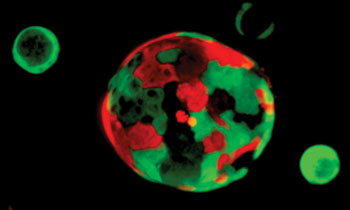Organoids Aid Discovery of New Approaches for Treating Pancreatic Cancer
By LabMedica International staff writers
Posted on 26 Jan 2015
Cancer researchers have established a method for culturing organoids from normal and cancerous mouse and human pancreatic tissues that is expected to boost development of personalized treatment approaches for this deadly disease.Posted on 26 Jan 2015
Since pancreatic cancer is one of the most lethal malignancies due to its late diagnosis and limited response to treatment, methods to identify and study molecular pathways involved in tumor development are urgently needed. Towards this end investigators at Cold Spring Harbor Laboratory (NY, USA) established organoid models from normal and cancerous mouse and human pancreas tissues. Pancreatic organoids could be rapidly generated from resected tumors and biopsies, survive cryopreservation, and exhibit ductal- and disease-stage-specific characteristics. Normal ductal cells that are able to develop into pancreatic cancer represent only about 10% of the cells in the pancreas, but the organoids were entirely composed of ductal cells, which eliminated surrounding cell types that often contaminate pancreatic samples.

Image: Researchers have developed a three-dimensional culture system to grow organoids from mouse and human pancreatic tissue. The technology promises to change the way pancreatic cancer research is done, offering a path to personalized treatment approaches (Photo courtesy of Cold Springs Harbor Laboratory).
Details published in the December 2014 online edition of the journal Cell revealed that the organoids were grown as hollow spheres within a complex gel-like substance filled with growth-inducing factors and connecting fibers. Once they had grown to a sufficient size, the organoids were transplanted into mice, where they fully recapitulated all the stages of pancreatic cancer development from early-grade neoplasms that progressed to locally invasive and metastatic carcinomas.
Due to their ability to be manipulated genetically, organoids served as an ideal platform to probe genetic cooperation. Comprehensive transcriptional and proteomic analyses of mouse pancreatic organoids revealed genes and pathways altered during disease progression. The confirmation of many of these protein changes in human tissues demonstrated that organoids were a useful model system to discover characteristics of this deadly malignancy.
“With this development, we are now able to culture both mouse and human organoids, providing a very powerful tool in our fight against pancreatic cancer,” said senior author Dr. David Tuveson, professor of pancreatic cancer medicine at Cold Spring Harbor Laboratory. “We hope to make this available to the entire pancreatic cancer research community.”
Related Links:
Cold Spring Harbor Laboratory













